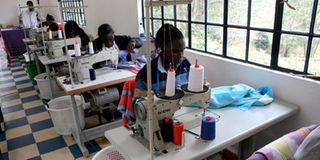Premium
Funding small, medium-sized manufacturing firms will spur economic growth

Workers at a Nairobi- based textile factory. Kenya has launched a trading board on the Nairobi Securities Exchange (NSE) for small and medium enterprises (SMEs) that opens new funding opportunities for the growing pool of small and medium sized businesses.
Job creation is back in the news, thanks to the release of the Economic Survey 2022, which shows a robust gross domestic product (GDP) growth of 7.5 per cent in 2021. Critics have pointed out, however, that the growth did not create many formal sector jobs nor grow individual incomes substantially. Rather, corporate profits rebounded and the stock of public assets grew commendably.
Of the 926,1000 new jobs reported in 2021, only 172,300 or 19 per cent were in the modern or formal sector. Annual average earnings per employee increased by 2.3 per cent compared to inflation, which averaged 6.1 per cent.
The questions of jobless growth and sluggish increase in real incomes are as old as independent Kenya. I have previously highlighted the 1972 ILO diagnostic of our economy, titled Employment, Incomes and Equality. We achieve commendable GDP growth rates but are not changing peoples’ lives at the desired rate.
Economists say the twin issues can only be solved by changing the fundamental structure of the economy. Agriculture, forestry and fishing remain dominant at 22.4 per cent of the economy. Transport contributes 11.4 per cent, real estate 8.9 per cent, manufacturing 7.2 per cent, finance and insurance 7.1 per cent and information and communication 2.4 per cent.
Failed long rains
Agriculture contracted in two of the last five years – first in 2017 (-1.4 per cent) and again in 2021 (0.1 per cent) and grew modestly (2.8 per cent) in 2019. It performed well in 2018 and 2020, expanding by 6.1 per cent and 5.2 per cent respectively. Given the failed long rains, the outlook for 2022 is poor.
Manufacturing expanded by six per cent by volume and 13.2 per cent by value. But wages in the sector are yet to recover to 2019 levels, when it employed 329,000. Meanwhile agriculture has 295,300 formal wage employees and at Sh328,000 per year, the wage is way less than in manufacturing and has stagnated since 2017.
Agricultural productivity depends on manufacturing. It is the latter that provides tools, equipment and machines. Of the many things we need to fix to make manufacturing work, let us explore affordable credit.
IDB Capital and ICDC, (which merged to form Kenya Development Corporation – KDC), Development Bank of Kenya (DBK) and Kenya Industrial Estates (KIE) are the specialist institutions that finance manufacturing.
Credit to manufacturing by the entire fraternity was a paltry 1.4 billion in 2021. That supported 328 projects in the fields of food products, textiles, fabrication and electrical accessories. Commercial banks reported a 13 per cent growth in credit to manufacturing at 462.6 billion. These efforts are totally inadequate.
In the same period, the Laikipia economic stimulus programme, a collaboration with leading financial institutions, extended Sh174 million to 380 small manufacturing firms. We need to channel at least Sh150 billion per year to homegrown small and medium-sized manufacturing firms and move beyond consumer to primary manufacturing.
@NdirituMuriithi is the Governor of Laikipia County.





